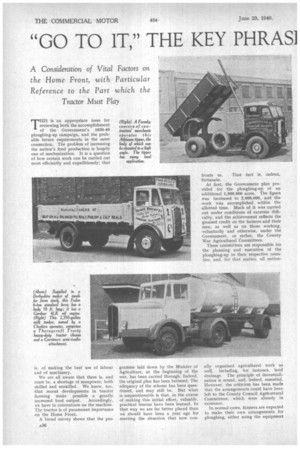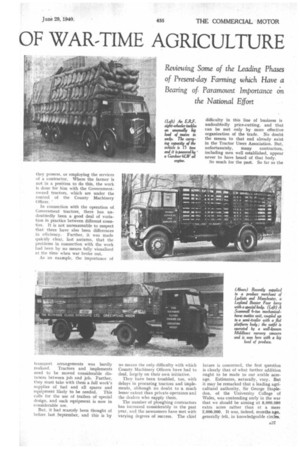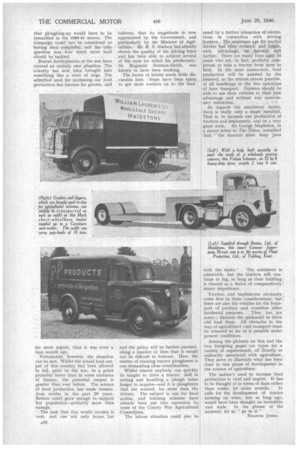"GO TO IT," THE KEY PHRAS1 OF WAR-TIME AGRICULTURE
Page 62

Page 63

Page 64

If you've noticed an error in this article please click here to report it so we can fix it.
THIS is an appropriate issue for reviewing both the accomplishment of the Government's 1939-40 ploughing-up campaign, and the probable future requirements in the same connection. The problem of increasing the nation's food production is largely one of mechanization. It is a question of how certain work can be carried out most efficiently and expeditiously; that
is, of making the best use of labour and of machinery.
We are all aware that there is, and must be, a shortage of manpower, both skilled and unskilled. We know, too, that recent developments in tractor farming make possible a greatly increased food output. Accordingly, we have to concentrate on the machine. The tractor is of paramount importance on the Home Front.
A broad survey shows that the pro
gramme laid down by the Minister of Agriculture, at the beginning of the war, has been carried through. Indeed, the original plan has been bettered. The adequacy of the scheme has been questioned, and may still be. But what is unquestionable is that, in the course of making this initial effort, valuable, practical lessons have been learned. In that way we are far better placed than we should have been a year ago for meeting the situation that now con fronts us. fortunate. That fact is, indeed, At first, the Government plan provided for the ploughing-up of an additional 1,500,000 acres. The figure was increased to 2,000,000, and the work was accomplished within the allotted time. Much of it was carried out under conditions of extreme difficulty, and the achievement reflects the greatest credit on the farmers and their men, as well as on those working, voluntarily and otherwise, under the Government, or rather, the County War Agricultural Committees.
These committees are responsible for the planning and execution of the ploughing-up in their respective counties, and, for that matter, all nation ally organized agricultural work as well, including, for instance, land drainage. The principle of decentralization is sound, and, indeed, essential. However, the criticism has been made that the arrangements could have been left to the County Council AgrIcuttural Committees, which were already in existence.
In normal cases, farmers are expected to make their own arrangements for ploughing, either using the equipment they possess, or employing the services of a contractor. Where the farmer is not in a position to do this, the work is done for him with the Governmentowned tractors, which are under the control of the County Machinery Officer. "
In connection with the operation of Government tractors, there has undoubtedly been a good deal of variation in practice between different counties. It is not unreasonable to suspect that there have also been differences in efficiency. Further, it was made quickly clear, last autumn, that the problems in connection with the work had been by no means fully visualized at the time when war broke out.
As an example, the importance of transport arrangements was hardly realized. Tractors and implements need to be moved considerable distances between job and job. Further, they must take with them a full week's supplies of fuel and all spares and equipment likely to be needed. This calls for the use of trailers of special design, and such equipment is now in considerable use.
But, it had scarcely been thought of before last September, and this is by no means the only difficulty with which County Machinery Officers have had to deal, largely on their own initiative.
They have been troubled, too, with delays in procuring tractors and implements, although no doubt to a. much lesser extent than private operators and the dealers who supply them.
The number of ploughing contractors has increased considerably in the past year, and the newcomers have met with varying degrees of success. The chief difficulty in this line of business is undoubtedly price-cutting, and that can be met only by more effective organization of the trade. No doubt the means to that end already exist in the Tractor Users Association. But, unfortunately, many contractors, including men well established, appear never to have heard of that body.
So much for the past. So far as the
future is concerned, the first question is clearly that of what further addition ought to be made to our arable acreage. Estimates, naturally, vary. But it may be remarked that a leading agricultural authority, Sir George Stapledon, of the University College of Wales, was contending early in the war that we should be aiming at 8,000,000 extra acres rather than at a mere 2,000,000. it was, indeed, months ago, generally felt, in knowledgeable circles.
that ploughing-up would have to be intensified in the 1940-41 season. The campaign could not be considered as having been eornpleted; and the only question was how much more land should be tackled.
Recent developments of the war have created an entirely new situation. The country has now been brought into something like a state of siege. The admitted need for increasing our food production has become far greater, and far more urgent, than it was even a bare month ago.
Fortunately, however, the situation can be met. Whilst the actual food output of this country had been allowed to fall, prior to the war, to a point probably lower than in some centuries of history, the potential output is greater than ever before. The science of food production has made tremendous strides in the past 20 years. Britain could grow enough to support her population—probably more than enough.
The task that this would involve is vast, and one not only hopes, but
believes, that its magnitude is now appreciated by the Government, and particularly by the Minister of Agri. culture.Mr.-R. S. Hudson'has already' shown the quality of his driving force and has been able to achieve, several of the ends for which his predecessor, Sir Reginald Dorman-Smith, was known to have been working.
. The factor of labour needs little discussion here. Steps have been taken. to get more workers on to the land
and the policy will be further pursued, along a number of lines that it would not be difficult to forecast. Here, the matter of training tractor ploughmen is one demanding close consideration.
Whilst almost anybody can quickly • be taught to drive a tractor, skill in setting and handling a plough takes longer to acquire—and it is ploughmen that are wanted, far more than the drivers. The subject is one for local action, and training schemes have already been put into operation by some of the County War Agricultural Committees.
The labour situation could also be
eased by a further relaxation of restrictions in connection with driving licences. The minimum age for tractor drivers has' ben • reduced; and might, with advantage, be lowered still farther. There are many boys aged 14 years who are, in fact, perfectly competent to take a tractor from farm to field. In the same connection, food production will be assisted by the removal, to the utmost ,extent possible, of all handicaps to the free operation of farm transport. Farmers should be able to use their vehicles to their best advantage and without any unnecessary restriction.
As regards the machinery factor, there is really only a single essential. That is, to increase our production of tractors and implements, and on a very great scale. Sir George Stapledon, in a recent letter to The Times, remarked that " the tractors must keep pace
with the tanks." The sentiment is • admirable, but the tractors will continue to lag, so long as their building. is tieated as a factor of comparatively minor importance.
Tractors and implements obviously , come first in these considerations, but there are also the vehicles for the transport of produce and countless other incidental purposes. They, too, are scarce ; likewise the personnel to drive and load them. All obstacles in the way of agricultural road transport must be removed so far as is possible under present conditions.
Among the pictures on this and the two foregoing pages are types for a variety of requirements, all directly or indirectly associated with agriculture.. They serve to illustrate what has been done in this phase of development in the science of agriculture.
The nation's need to increase food production is vita) and urgent. It has to be thought of in terms of days rather
than weeks, letalone months. It calls for the development of tractor farming on what, not so long ago, would have been thought an incredibly vast scale. In the phrase of the moment, let us " go to it." • FRANCIS JONES.




























































































